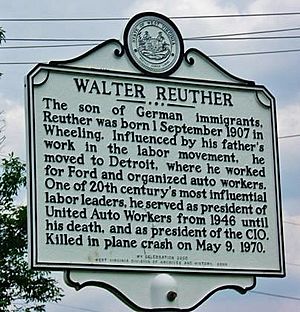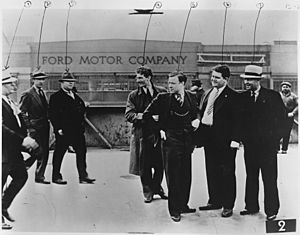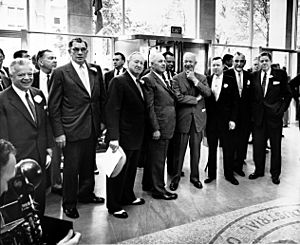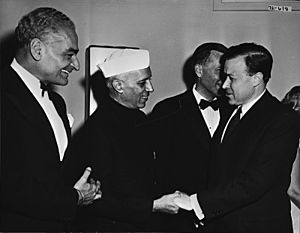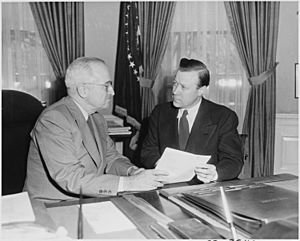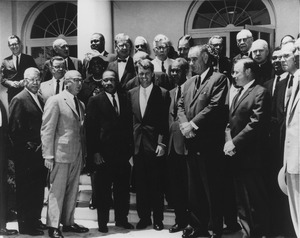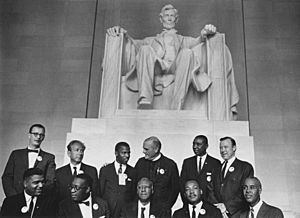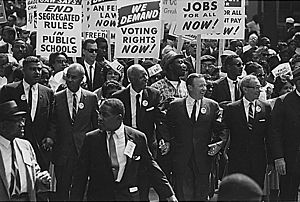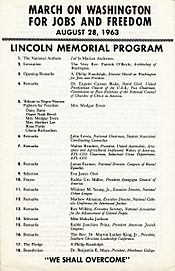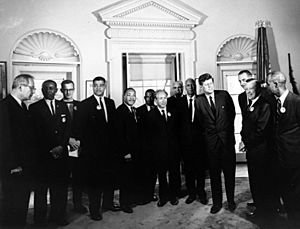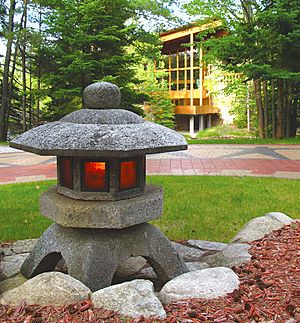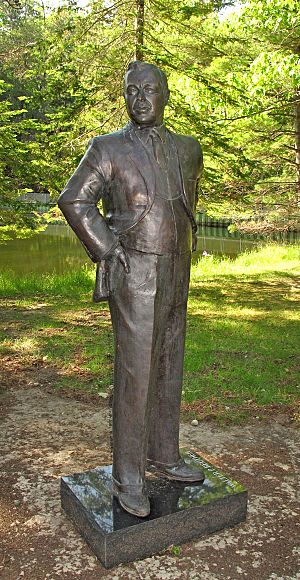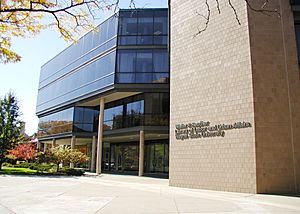Walter Reuther facts for kids
Quick facts for kids
Walter Reuther
|
|
|---|---|
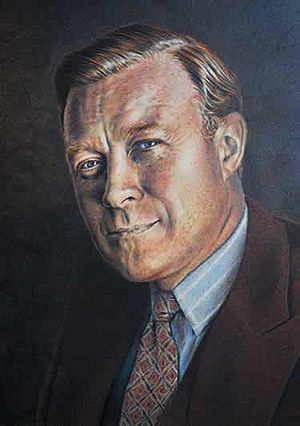
Portrait of Reuther
|
|
| 4th President of the United Automobile Workers | |
| In office 1946–1970 |
|
| Preceded by | R.J. Thomas |
| Succeeded by | Leonard F. Woodcock |
| 3rd President of the Congress of Industrial Organizations | |
| In office 1952–1955 |
|
| Preceded by | Philip Murray |
| Succeeded by | George Meany |
| Personal details | |
| Born |
Walter Philip Reuther
September 1, 1907 Wheeling, West Virginia, U.S. |
| Died | May 9, 1970 (aged 62) Pellston, Michigan, U.S. |
| Cause of death | Plane crash |
| Political party | Democratic |
| Spouse |
May Wolf
(m. 1936) |
| Children |
|
| Parents |
|
| Relatives |
|
| Education | Wayne State University (withdrew) |
| Occupation |
|
| Known for | labor movement, civil rights movement |
| Awards |
|
| Signature | |
Walter Philip Reuther (September 1, 1907 – May 9, 1970) was an American leader who worked for the rights of workers and for civil rights. He helped build the United Automobile Workers (UAW) into a very forward-thinking labor union.
Reuther believed that labor unions should not just help their members. He thought they should also work for social justice and human rights for everyone. He used the UAW's power to support workers' rights, civil rights, women's rights, universal health care, public education, and environmental protection. He also believed in peaceful ways to make changes in society.
He helped start the AFL-CIO in 1955, which is a large group of labor unions. Walter Reuther survived two attempts on his life. He was the fourth and longest-serving president of the UAW, from 1946 until he died in 1970.
As a leader of five million autoworkers, Reuther had a lot of influence in the Democratic Party. He helped create the Peace Corps and supported important laws like the Civil Rights Act of 1964 and the Voting Rights Act of 1965. He also worked closely with President Lyndon B. Johnson on programs to help people, known as the Great Society and War on Poverty.
Reuther was a strong friend of Martin Luther King, Jr. and the civil rights movement. He marched with King in many cities, including Detroit and Selma. When King was jailed in Birmingham, Reuther helped raise money to free the protesters. He also helped organize the March on Washington for Jobs and Freedom in 1963, where he spoke just before King's famous "I Have a Dream" speech.
He was an early supporter of Cesar Chavez and the United Farm Workers. Reuther also helped organize the first Earth Day on April 22, 1970. Time Magazine called him one of the 100 most important people of the 20th century. In 1995, he was given the Presidential Medal of Freedom after his death.
Contents
- Walter Reuther's Early Life and Learning
- United Automobile Workers
- Walter Reuther's Ideas and Actions
- Walter Reuther's Death
- Walter Reuther's Personal Life
- Awards and Recognitions
- Walter Reuther's Legacy
- Records and Archives
- See also
Walter Reuther's Early Life and Learning
Walter Reuther was born on September 1, 1907, in Wheeling, West Virginia. His parents, Anna and Valentine Reuther, were German-Americans. His father, Valentine, was a beer wagon driver and a union organizer. He taught his five children, Ted, Walter, Roy, Victor, and Christine, to think about important social issues.
Walter learned about unions from his father every day. He remembered his father saying, "We got the struggles, the hopes and the aspirations of working people every day." As a child, Walter and his brother Victor visited Eugene V. Debs in jail. Debs was a labor leader jailed for his peaceful actions during World War I.
The Reuther family was careful with money. Walter's mother made clothes from used flour sacks. When his father was hurt in an accident, Walter started doing odd jobs at age nine to help the family. He left high school early to work in a factory. There, he learned about unsafe working conditions when he cut his toe in an accident.
The Reuther boys also learned about racism. Their father told them never to treat anyone badly after they saw people throwing rocks at black travelers. This lesson stayed with them, and they spent their lives fighting for fairness for all people.
Moving to Detroit
In 1927, at age 19, Reuther moved to Detroit. He got a job at Ford Motor Company as an expert tool and die maker. He was very skilled, even though he was young. He finished high school while working at Ford and went to Detroit City College, now Wayne State University. In 1932, he was fired for organizing a rally for a Socialist presidential candidate. Walter and Victor then decided to travel the world.
Traveling the World
Walter and Victor traveled for three years. They worked in an auto plant in the Soviet Union, teaching workers how to use machines. The factories were very cold. Walter often wrote letters criticizing how the communists ran the plants.
After almost two years, they traveled through Turkey, Iran, British India, and China. They ended their trip by bicycling through Japan. When they returned to Detroit, their brother Roy was already helping to organize autoworkers. Walter said his trip taught him that "all people long for the same basic human goals." He wanted to help American workers build strong unions.
United Automobile Workers
First Win Against Car Companies
When Reuther returned to Detroit, he became president of UAW Local 174. With his brother Victor, he led the first successful strike against Kelsey Hayes. This company made parts for Ford. Workers were upset because the assembly line was too fast. They were getting hurt trying to keep up.
In December 1936, workers surprised the company by sitting down in the plant and refusing to leave. Thousands of supporters blocked the doors. Ford needed the parts, so after 10 days, the company agreed to talk. This was the UAW's first big win. Women workers won equal pay: 75 cents an hour. The assembly line speed was slowed, and workers could not be fired for joining the union. Local 174's membership grew from 200 to 35,000 in one year.
Fighting General Motors
In 1936, General Motors (GM) was the biggest company in the world. Many of its plants were in Flint, Michigan. Reuther's brother, Roy, planned to organize workers there. The strike began on New Year's Eve, December 31, 1936. Workers sat down in the plants and refused to leave. GM turned off the heat.
Walter Reuther led a strike in Detroit to support the Flint workers. Other strikes happened in California, Pontiac, and St. Louis. Police tried to force the Flint workers out in what was called the "Battle of Bulls Run." Police used tear gas and shot at workers, sending 13 to the hospital. Victor Reuther encouraged workers to fight back using fire hoses and slingshots.
Michigan Governor Frank Murphy sent 2,000 National Guard members to keep the peace, not to remove the workers. Workers took control of the only plant that made Chevrolet engines. After 44 days, General Motors had to recognize the union. This strike was a huge victory for workers' rights.
In 1950, Reuther signed the "Treaty of Detroit" with GM. This five-year contract gave workers better pay, health care, and pensions. In return, the union promised not to strike. Fortune Magazine said this agreement helped workers become part of the middle class.
Taking on Chrysler
Chrysler was the next target for the UAW. In March 1937, 60,000 Chrysler workers went on strike. When police hurt strikers, 150,000 people protested in Detroit. After four weeks, Chrysler also signed an agreement with the UAW.
Facing Ford Motor Company
Henry Ford had said he would never let his workers join a union. His security chief, Harry Bennett, used 3,000 men to scare and beat workers who supported unions. In 1932, five workers were shot and killed during a protest at the Ford River Rouge Complex.
In May 1937, Reuther and other UAW leaders tried to hand out flyers at a Ford plant. Bennett's men attacked them, beating them badly. This event became known as the "Battle of the Overpass." Photographers were attacked, but one camera saved pictures. The photos became national news, showing how Ford's men brutally beat union organizers.
This violence turned public opinion against Henry Ford. Time magazine published the photos. Ford stopped advertising in Time, Life, and Fortune magazines. It took four more years, but in 1941, Henry Ford finally signed an agreement with the UAW.
Years later, Reuther and Henry Ford II, Henry Ford's grandson, visited a new engine plant. Ford II joked, "Walter, how are you going to get these robots to pay union dues?" Reuther famously replied, "Henry, how are you going to get them to buy your cars?"
"500 Planes a Day"
In 1940, during World War II, the U.S. was making planes slowly. Reuther suggested using car factories to make planes. He proposed the "Reuther Plan: 500 Planes a Day" in December 1940. He said, "America's can be won on the assembly lines of Detroit."
President Franklin D. Roosevelt liked the idea and met with Reuther. Car companies did not like the plan. They wanted the government to build new factories for them. But after the attack on Pearl Harbor in 1941, many of Reuther's ideas were used. Detroit's car plants made many planes and tanks. This helped the Allies win the war.
By 1943, Chrysler said it had changed 89% of its machines for wartime production. Fortune magazine wrote that Reuther was "right on track." In 1953, President Eisenhower thanked Reuther for the "magnificent performance" in supplying planes and tanks.
Becoming UAW President
After the war in 1945, Reuther led a strike against GM. He wanted workers to get a 30% raise without increasing car prices. This was unusual because companies usually raised prices when wages went up. After a 113-day strike, workers got an 18.5 cent hourly raise. This bold leadership helped Reuther become the UAW president.
On March 27, 1946, Reuther won the election to become UAW president. He won by only 124 votes. He promised to fight for the good of all people, not just union members. One of his first actions was to fight to allow black bowlers in the American Bowling League. He saw the labor movement as a way to make big social changes.
His Salary
Reuther kept his salary low, never more than $31,000 a year. This was much less than other union presidents. He did this to stay connected to UAW members and show he was with them. He cared more about the union's success than about money.
Removing Communists from Unions
After Reuther became president, there were many fights within the UAW. Some leaders supported Communists. In November 1947, Reuther won another election by a large margin. This greatly weakened the Communists' power in the union. Life magazine called his victory "the biggest setback of all time for the Communists in the American Labor Movement."
Leading the CIO
Reuther became president of the Congress of Industrial Organizations (CIO) in 1952. He worked to remove Communist leaders from unions within the CIO. This was seen as a big win for democracy in America. A Soviet newspaper called Reuther a "traitor," but the Republican Party called him "the most dangerous man in America." Despite this, J. Edgar Hoover, head of the FBI, always suspected Reuther because he had worked in Russia.
In 1959, Reuther met with Soviet Premier Nikita Khrushchev in San Francisco. They talked about capitalism, communism, and relations between the U.S. and Russia. This meeting was big news worldwide.
How He Bargained for Workers
As UAW president, Reuther got amazing benefits for autoworkers. These included yearly raises, cost-of-living increases, unemployment benefits, early retirement options, and health care.
He used a smart strategy called "pattern bargaining" against the Big Three car makers: GM, Ford, and Chrysler. He would pick one company to bargain with first. If that company refused his demands, he would threaten a strike. This would stop production at that company, while its rivals kept making cars and selling them. To avoid losing sales, the first company would often agree. Then, Reuther would use that agreement as a model for the other companies. This way, he got good deals for workers and avoided many costly strikes.
Walter Reuther's Ideas and Actions
Peace Corps Idea
In 1950, Reuther suggested that the U.S. create a group for young Americans to help people around the world. He said, "the more young Americans who are trained... to help people help themselves... the fewer young people will need to be sent with guns."
In 1960, Reuther met with John F. Kennedy. Reuther convinced Kennedy to create this group, which became the Peace Corps. Kennedy announced the idea on October 14, 1960, at the University of Michigan.
Working for Civil Rights
Reuther strongly supported the Civil Rights Movement. He marched with King in Selma, Birmingham, and Jackson. When King was jailed in Birmingham, Reuther helped get $160,000 to free the protesters. He also helped plan and pay for the March on Washington for Jobs and Freedom in 1963. He spoke at the Lincoln Memorial just before King's "I Have a Dream" speech.
He was on the board of the National Association for the Advancement of Colored People (NAACP). In 1954, the UAW gave $75,000 to the NAACP to help with the Brown v. Board of Education case. This case ended segregation in schools. King praised Reuther for his strong support for justice.
In the 1930s, Reuther fought racism as a student. When a hotel would not let black students use its pool, he organized a protest. The hotel then closed the pool to everyone. President Barack Obama later said that Reuther and the UAW helped bring about civil rights because they believed in fairness for all workers.
Detroit Walk to Freedom, 1963
The Detroit Walk to Freedom was a large march on June 23, 1963, in Detroit, Michigan. It protested racism and unfair treatment of African Americans in both the South and the North. About 125,000 people attended, making it the largest civil rights protest at that time.
Reuther helped organize the march and let King use office space at the UAW headquarters. Reuther marched with King and spoke at Cobo Hall. There, King gave an early version of his "I Have a Dream" speech.
March on Washington, 1963
The March on Washington for Jobs and Freedom was held on August 28, 1963, in Washington, D.C.. It called for civil and economic rights for African Americans. Reuther helped organize the march with other leaders. He convinced them to hold the march at the Lincoln Memorial instead of the Capitol. He thought it would be less threatening and more fitting. Reuther also paid for a $19,000 sound system so everyone could hear.
The UAW paid for buses for 5,000 of its members, making it the largest group there. The UAW also brought thousands of signs for marchers. Reuther was the most important white speaker. He told Americans to push politicians to fix racial problems. He said, "American democracy is on trial in the eyes of the world."
After the march, civil rights leaders met with President Kennedy. Reuther told Kennedy that businesses needed to solve racial problems with "reason or riots." He warned that a "civil war" over rights would be fought "in your backyard."
Selma Voting Rights Movement, 1965
On March 9, 1965, after "Bloody Sunday" in Selma, Alabama, Reuther sent a message to President Johnson. He asked Johnson to use federal power to protect civil rights marchers. He said the violence was "an outrage against all decency."
Reuther attended a memorial service in Selma for a minister who was killed. A picture of King, Reuther, and other leaders in Selma appeared on the cover of Life magazine.
Cesar Chavez and Farm Workers, 1965
In December 1965, Reuther visited Cesar Chavez and striking grape workers in Delano, California. Reuther's visit brought national attention to Chavez's fight. Reuther marched with Chavez and promised $7,500 a month from the UAW to the United Farm Workers.
Reuther also asked Senator Robert F. Kennedy to visit Chavez. Kennedy did, becoming a strong supporter. Reuther visited Chavez many times, including during a hunger strike. He gave Chavez a $50,000 donation. The United Farm Workers named a building after Reuther's brother Roy to honor their support.
March Against Fear, 1966
After civil rights activist James Meredith was shot, Reuther and his wife May marched in Jackson, Mississippi. They marched with King and his wife Coretta, bringing 10 buses of union supporters.
Memphis Sanitation Strike, 1968
On April 8, four days after King was killed, Reuther marched in Memphis, Tennessee. He supported the striking sanitation workers. He also gave $50,000 from the UAW to the workers, the largest donation from outside.
Caring for the Environment
Reuther wanted to build an environmental movement for everyone. In 1965, the UAW held a "Clean Water Conference." Reuther called for a "crusade not only for clean water, but also for cleaning up the atmosphere." In 1967, he created a UAW department to fight pollution, including car emissions. He warned that society might "suffocate" in its own waste if it did not act.
Earth Day
Reuther made the first donation of $2,000 to support the first Earth Day in 1970. The UAW also paid for phone lines for organizers and printed all the materials. They encouraged members to join Earth Day events across the country. Denis Hayes, the main organizer, said, "Without the UAW, the first Earth Day would have likely flopped!" After Reuther's death, the Earth Day organizers dedicated a book to him.
Redwood National Park
Reuther supported creating Redwood National Park. In 1966, he wrote to President Johnson, saying that saving these huge trees would be a "monumental step." He supported a 90,000-acre park. President Johnson promised to establish the park.
Fighting the Filibuster
In 1957, Reuther called the U.S. Senate "the graveyard of civil rights legislation." He wanted to get rid of the filibuster, a rule that can stop laws from being passed.
Walter Reuther's Death
On May 9, 1970, Walter Reuther, his wife May, and four others died in a plane crash. Their chartered Learjet 23 crashed near Pellston, Michigan, in rain and fog. The plane was approaching the airport near the UAW's Black Lake facility. Investigators found problems with the plane's altimeter.
Journalist Michael Parenti noted that Reuther's death was part of a time when many important leaders died, including John F. Kennedy and Martin Luther King.
Funeral Service
Reuther's funeral was held on May 15, 1970, in Detroit. About 3,400 people attended. Coretta Scott King spoke, saying, "Walter Reuther was to black people, the most widely known and respected white labor leader in the nation." She remembered him marching in many civil rights events. She said he was a "big man" with "grand ideas" who fought for the whole world.
Walter Reuther's Personal Life
Walter and May Wolf Reuther married on March 13, 1936. They had two daughters, Linda (born 1942) and Elisabeth (born 1947).
Reuther lived a simple life. He did not smoke or drink. For lunch, he always had a sandwich and tea. He woke up early. People who knew him said he was a very disciplined person.
To relax, he liked to hike, fish, and play tennis. He enjoyed German, Classical, and Union songs. Although some thought he was serious, his friend Irving Bluestone said he had a good sense of humor.
Reuther loved working outdoors. He built a fish ladder and a Japanese Garden at his home near Rochester, Michigan. He and his daughter Lisa planted over 50 types of trees. He was also a skilled woodworker and built much of his home's furniture. After an assassination attempt in 1948, which badly hurt his arm, he rebuilt his arm by working on his house. He joked, "I got a good house and a good hand, all for the same money."
May Reuther was Walter's close advisor. She was a teacher and helped organize a teachers' union. She later became Walter's full-time secretary. She was active in many charities and marched with Walter in civil rights protests. She hosted Eleanor Roosevelt at their home. After the assassination attempt on Walter, May focused on giving their daughters a normal life. The family had bodyguards and attack dogs for their safety.
Awards and Recognitions
- In 1955, he received the Social Justice Award.
- He received the Eugene V. Debs Award in 1968 for his work in unions.
- He was given the Histadrut Humanitarian Award in 1958.
- The Weizmann Institute of Science in Israel gave him an award in 1968.
- He received honorary degrees from many universities, including Harvard University and University of Michigan.
- There are portraits and a sculpture of Reuther at the Smithsonian Institute's National Portrait Gallery.
- Reuther appeared on the covers of Time Magazine twice and Newsweek three times.
Walter Reuther's Legacy
Time Magazine named Reuther one of the 100 most important people of the 20th century. In 1995, President Bill Clinton gave him the Presidential Medal of Freedom after his death. Clinton said Reuther was a "visionary so far ahead of his times." Journalist Murray Kempton said Reuther was "the only man I have ever met who could reminisce about the future."
- He is on Time magazine's list of the 100 most important people of the 20th century.
- He was added to the Department of Labor's Hall of Honor.
- The Walter P. Reuther Humanitarian Award was created in 1999 by Wayne State University.
- The Reuther-Chavez Award was created in 2002 to honor those who help workers' rights.
- A seven-foot bronze statue of Walter Reuther was dedicated in 2006 in Wheeling, West Virginia.
- Reuther's home in Rochester, Michigan, was listed on the National Register of Historic Places in 2002.
Walter P. Reuther Humanitarian Award
In 1999, Wayne State University, with the UAW and Reuther's family, created this award. It honors people who show Reuther's spirit and values. Winners include Rosa Parks, John Dingell, Joseph Lowery, Douglas Fraser, and John Lewis.
Places Named for Reuther
- Walter P. Reuther Library of Labor and Urban Affairs at Wayne State University in Detroit, Michigan.
- Walter P. Reuther Freeway (I-696) in Detroit.
- Walter and May Reuther Family Education Center in Black Lake, Michigan.
- Walter Reuther Psychiatric Hospital in Westland, Michigan.
- Reuther Middle School in Rochester, Michigan.
- Walter Reuther Central High School in Kenosha, Wisconsin.
- Reuther Way street in Janesville, Wisconsin.
- The Walter Reuther Center for youngsters in Holon, Israel.
Records and Archives
Most of Walter Reuther's records are kept at the Walter P. Reuther Library of Labor and Urban Affairs. This collection includes his letters, writings, photos, and official documents from his time as UAW President. Researchers can contact the library to learn more or to see the materials.
See also
- United Automobile Workers
- American Federation of Labor-Congress of Industrial Organizations
- Americans for Democratic Action
- Walter P. Reuther Library
- List of civil rights leaders
- Walter P. and May Wolf Reuther House


